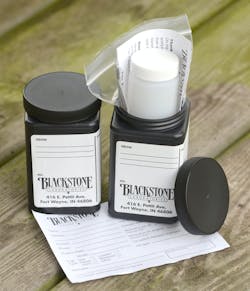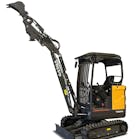If you need a thumbnail application guide for the new oils, CK-4 is backward compatible with previous-generation oils and is suited for use in both new diesels and old diesels, whether on-road or off-road. FA-4 is primarily (but perhaps not exclusively) for certain heavy-duty on-highway diesel engines to be introduced in late 2016 and in 2017.
Same Grade Designation, Dissimilar Viscosity?
The grade stated on a can of oil is an SAE (Society of Automotive Engineers) designation based on the results of the “kinematic viscosity test,” which basically measures how fast an oil at 100 C flows through a tube via gravity. Viscosities in this test are measured in “centistokes” (cSt); oil qualifying for a 10W30 designation, for example, can range from 9.3 to 12.5 cSt. New CK-4 oils will have ratings around 12.0-12.5 cSt, and FA-4 oils will be blended down near 9.3-cSt, making them significantly thinner than 10W30 CK-4 formulations.
Compared with CJ-4, both new oils are formulated to do a better job at a number of engine-protecting tasks: to better resist oxidation—a process that thickens oil, forms deposits, and promotes corrosion; to better control aeration (entrained air and foam) that can impair heat transfer and retard oil supply; and to enhance shear-stability to better maintain the oil’s stated viscosity range by using viscosity-stabilizing polymers that are more resistant to being broken apart (sheared) by the engine’s working parts. The concern was that some CJ-4 formulations were shearing out of grade and not providing the required oil-film thickness between parts.
Viscosity differences
Why two new oils? The answer comes back to viscosity, defined as the extent to which a fluid resists the tendency to flow. FA-4 formulations, compared with those for CK-4, have lower viscosities in order to reduce the resistance the oil presents to moving engine parts, thus reducing fuel consumption. The analogy sometimes used is that of running in a pool with water to your waist, versus running in water just knee deep.
Even though CK-4 and FA-4 formulations might both be classed, say, 10W30, viscosity will not be the same. An oil’s grade actually represents a range of viscosity measurements determined by two different laboratory test methods. As long as an oil’s viscosity falls within the range designated for 10W30, that’s the way it’s graded. FA-4 formulations, however, fall at the lower end of the test scales, making them significantly thinner than CK-4 oils that fall higher on the scales. The lesser viscosity of FA-4 formulations is the reason these oils have limited backward compatibility.
A suggested practical approach for fleet managers having a mix of old and new trucks and a mix of old and new off-road equipment is to use CK-4 across the board, in a grade sanctioned by the engine manufacturer. This approach, say proponents, ensures maximum protection for these engines and standardizes on one product. The only compromise, they say, is some degree of fuel-economy loss in FA-4-compatible engines. But caution here: If the engine manufacturer calls for FA-4, talk to a competent oil supplier before substituting CK-4.
Oil-drain intervals
When the industry heard about the enhanced qualities of CK-4 and FA-4, equipment users generally seemed to assume that extended drain intervals would be included on the list of benefits. Although indications are that the assumption will likely prove generally true, all the evidence is not yet in.
“The new oils are highly advanced, well-engineered, and thoroughly validated,” says Jeromy Myers, Tier 4 Readiness/Migration, Caterpillar. “As such, they can offer performance that is superior to prior oil technologies. At the same time, however, engines also are highly engineered and employ complex emissions-reduction technologies. These engines can stress oil in ways different than older engine technologies.”
Brian Humphrey, OEM technical liaison, Petro-Canada Lubricants, Suncor, is of the opinion that well-formulated CK-4 oils, with high-quality base stocks and advanced additive packages, “will make it possible to extend drain intervals.” He advises caution, however, with FA-4.
“While FA-4-capable oils will have to pass the same stringent test requirements as CK-4 oils,” says Humphrey, “most OEMs and operators will be cautious with regard to drain intervals for these [FA-4] oils, with their lower High Temperature/High Shear [HT/HS] viscosity. [HT/HS is one of the viscosity tests]. So, for the first couple years, we believe most on-road vehicle operators trying FA-4 oils will be looking more for their 0.5- to 1.0-percent improvement in fuel economy, rather than extending drain intervals.”
Shawn Whitacre, senior staff engineer, Chevron, and chairman of the ASTM Heavy-Duty Engine Oil Classification Panel, takes a positive stance on extended drain intervals for both new oils.
“We anticipate the enhanced properties of both CK-4 and FA-4 to have a significant impact on oil drain intervals, due to the changes to the additive system,” says Whitacre. “One of the cornerstones to the new standards is the introduction of a new and very stringent test that measures oxidation performance. As this, in many cases, is the parameter that limits oil-drain intervals today, OEMs are evaluating how the new oils could enable longer oil-change intervals.”
Seemingly, too, the varying formulations of the new oils (base stock and specific additive package) could have an effect on oil-drain intervals.
“Generally speaking, CK-4 is more robust than existing CJ-4 in terms of oil performance and drain interval,” says Dr. Kenneth Chao, senior staff engineer, lubricants, John Deere. “However, exactly how much improvement from a particular CK-4 formulation, as compared with a CJ-4 oil, is difficult to quantify due to variation in the marketplace. It’s possible, too, that a premium-grade FA-4 oil might also be used for longer drain intervals—just like a premium CK-4. Among the design criteria [for the new oils] was to at least match the existing CJ-4 drain interval.”
From the oil-analysis point of view, little evidence is yet available to make judgments about drain intervals for the new oils.
“Given that we have to date received no samples of CK-4 or FA-4,” says Robin McNabb, data analysis manager, Polaris Laboratories, “we simply do not have the data to support or refute this [potentially longer drain intervals with the new oils].”
Kristin Huff, vice president, Blackstone Laboratories, reminds machine users that drain intervals are largely engine- and application-specific.
“It depends on the engine and how it’s used, of course,” says Huff. “Some engines do better than others on long oil-change intervals—no matter what oil is being used.”
Oil-analysis, filtration remain key
Determining optimum engine-oil drain intervals by analyzing the oil’s condition at specific intervals over time is among the most useful tools maintenance managers have for underpinning preventive-maintenance/condition-monitoring programs. Some fleet managers make the point that they will continue with established drain intervals until enough oil-analysis sampling history might indicate otherwise.
Bruce Reader, regional product support manager, Case, suggests that emissions-control systems—especially exhaust-gas recirculation, which can expose oil to high soot levels—can have a significant influence on an oil’s useful life, making oil analysis an essential tool for monitoring oil condition. He reminds machine owners that the value of oil analysis is its ability to reveal trends in engine condition over time, and that “one analysis does not make a trend.”
Blackstone’s Huff is of like opinion. “The most effective uses of oil analysis are preventive maintenance (finding potential problems before they take down an engine) and extending drain intervals. Most people don’t realize they can run the oil far longer than they currently are. So if the oil can handle more use, an analysis can determine that, and the lab can recommend how long to continue running before checking back.”
A question some fleet managers have raised is whether CK-4 and FA-4 will require different or added oil analysis tests.
“We’ve consulted with a number of oil companies in that regard,” says Polaris Laboratories McNabb, “and all indicated that the traditional tests are appropriate and applicable.”
Although testing will likely not be changing, Caterpillar’s Myers suggests a thorough initial analysis of the new oils.
“It is advisable to run a full battery of tests for a new oil, when introduced, in order to establish a baseline,” says Myers. “In-service lubricants are then compared with this baseline in order to evaluate changes accurately.”
Chevron’s Whitacre agrees. “As is always the case when changing to a new product, it’s important to reestablish ‘baselines’ with fresh samples of the new oils. End users can expect a different additive metal content with the new oils and possibly differences in kinematic viscosity [the second of the viscosity tests], depending on the viscosity grade of the old and new oils. As with any oil-analysis program, of course, it’s important not only to characterize baseline samples of oil, but also to conduct trend analysis to put test results in proper context.”
Construction Equipment asked a number of oil-analysis laboratories what they considered the standard tests for determining whether an oil is suitable to remain in service. Responses varied; most, however, offer a complete list of tests, some of which might be optional, allowing the analysis to be tailored to the application in consultation with the laboratory.
According to John Deere’s Chao, “essential tests” include an ICP (Inductively Coupled Plasma) elemental analysis for determining additive content and wear metals; FT-IR (Fourier Transform-Infrared Spectroscopy) tests for measuring oxidation, nitration, sulfation, glycol, water, fuel, and soot; total base number (TBN) or base number (BN) to determine base-type additives remaining to neutralize harmful acids; total acid number (TAN) or acid number (AN), a measure of corrosive organic and inorganic acids; and viscosity at 100 C.
“Determining optimum drain intervals requires a bit more than standard oil-analysis testing,” says Petro-Canada’s Humphrey, “and it’s best to pick a representative portion of the fleet to conduct additional testing. For instance, monitoring both the base number and acid number is one of the best ways to determine the optimum interval, but this testing [can be] more expensive. The representative units can provide an indication of optimum intervals, without breaking the program budget.”
Chevron’s Whitacre says that fleet managers should evaluate particular equipment and the duty cycle of these machines to determine the OEM-recommended oil-drain intervals most suited to the application.
“If optimization [of intervals] is desired,” says Whitacre, “it is advisable to start with a small group of units and evaluate used-oil parameters over time, using trend analysis and published condemning limits as the guide.”
On the practical side, Polaris Laboratories’ McNabb reminds fleet managers of analysis basics.
“Make certain there are procedures in place for collecting samples to ensure that this is done in a consistent manner,” says McNabb. “When, where, and how samples are collected can impact test results. Also, be sure there is a process for following up on abnormal and critical reports. And, in order to minimize the additional risk associated with increased drain intervals, there should be a conversation among the equipment owner, engine OEM, oil supplier, and analysis laboratory to ensure alignment.”
Of course, actually looking at the analysis reports is fundamental.
“You’d be surprised how many operators perform oil analysis, because it’s part of their program, but never look at the reports,” says Jason Rainey, owner of Apex Oil Lab. “To ensure that reports are as accurate as possible, make sure the asset hours, oil hours, oil brand, and oil type are correctly stated on the sample-submission information. Also, verify that the lab has set the limits correctly for each component type.”
From an oil-filtration standpoint, Veli Kalayci, director, engine liquid products, Donaldson Filtration Solutions, reminds fleet managers that filter performance, especially with the new FA-4 oil, is critical for optimum engine protection.
“The lower-viscosity oils will result in engine components being separated by a thinner film of oil,” says Kalayci. “The challenge for the filter will be to provide increased separation efficiency against even small contaminants, without increasing the pressure drop across the filter. In addition, [filter] manufacturers will have to validate their material compatibilities at higher temperatures in some applications. The validation will be needed to ensure that the filter will perform over its intended life in operating conditions at sustained higher temperatures.”
According to Kalayci, with the introduction of Tier 4 engines, some equipment manufacturers chose to control lube-oil contamination at finer levels, leading to the development of newer grades of synthetic filter media.
“Filters must be durable and deliver high contaminant capture, less restriction for better oil flow, and more contaminant-holding capacity for longer service life,” says Kalayci, “These characteristics all support extended drain intervals.”
Yet another filtration concern is that the high efficiency of premium filters can filter out beneficial additives in the new CK-4 and FA-4 oils, and that formulations and filterability will vary among oil brands and additive technologies.
Donaldson’s Kalayci responds. “While we are seeing this type of behavior on some fuel-filtration systems under circumstances influenced by [such factors as] fuel type, blend, additive content, and temperature, we have not observed such behavior with on-engine lube-filtration systems. Compared with fuel filters, lube-oil filters tend to be more open (less efficient) and lube oils tend to have more stable additives.”





